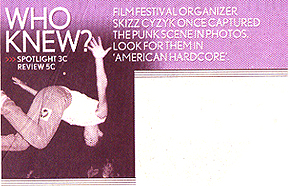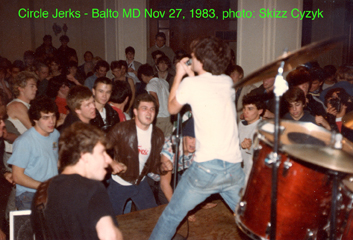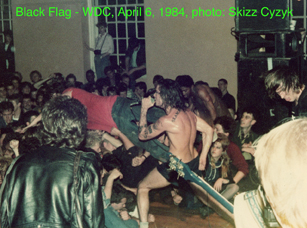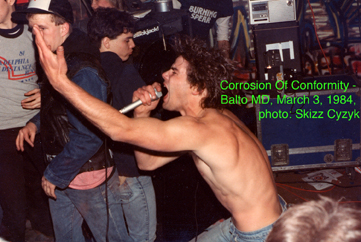
Reflections of his youth



Skizz Cyzyk, 40, is the fellow you want to see introducing a cranium-blowing short or a funky feature at the Maryland Film Festival. He never wears his erudition on his sleeve. His laid-back warmth sets a genial tone for audiences and filmmakers alike - welcoming but not unctuous.
He has maintained an authentic big-tent vision of the movies, whether working in his day job as programming manager of the Maryland Film Festival or directing the MicroCineFest of experimental, avant-garde or "psychotronic films," which he founded a decade ago. The "tenth and final" edition runs next weekend.
With his long hair and festival-functional clothing, Cyzyk has become such an emblem of amiability, it's a shock to see his name pop up on the end credits of Paul Rachman's hard-driving punk documentary, American Hardcore (opening today at The Charles Theatre). An unusually well-socialized film geek, perhaps - but a punk? Yet Cyzyk says American Hardcore tells a good part of his personal story. He contributed more than a score of still photos to Rachman's movie. They're mementos of what he considers a well-spent youth in Baltimore.
"My involvement with the punk movement was rooted in Baltimore," Cyzyk says in an e-mail. It was just what the culture doctor ordered to navigate adolescence.
"I was always the weird kid, and the punk scene was about being yourself and not conforming to society's rules, so I had finally found a place to fit in."
He turned on to punk in the '80s, when "all the bands had their own original take on it - you could tell them apart. Dead Kennedys didn't sound like Black Flag who didn't sound like the Misfits who didn't sound like Flipper, or Fear, or X, or Minor Threat, or Circle Jerks, and so on." And he grew so addicted to the music and the scene that even when he summered in Fenwick Island, Del., he'd commute to host a local-band radio show and spin punk discs during Psycho Drive Time for WCVT-FM.
None of Cyzyk's favorite bands "were on MTV or commercial radio," so he and his friends "felt like we had this really cool thing all to ourselves. I loved the new sounds, the energy, the lyrics, the artwork, and the whole D.I.Y. [do-it-yourself] aesthetic. I loved how I could go home after school and listen to a favorite record, and that weekend I might hang out with the people who made that record. My friends who were into Styx, Rush and AC/DC certainly couldn't do that."
He did more than just assiduously follow the scene. He joined bands with homegrown-exotic names like TRUD, Burried Droog and Slug Log 3, and also helped put together fanzines. "It was an all-encompassing part of my life," he says. And it had its own scruffy fraternity. "Everybody knew each other. When there was a show, everybody came regardless of who was playing. There were maybe only two or three shows a month. It was like a special club for misfits, where we felt safe."
That sense of safety sometimes proved illusory. "I knew kids who were thrown into mental institutions or military school because they came home with funny haircuts. High school and shopping malls were places where we were likely to get roughed up by jocks, rednecks and frat boys.
"These days jocks listen to Blink 182, punk shows happen at frat houses, a lot of rednecks love speed metal (which might not exist had it not been for hardcore thrash) and punk clothing is easily purchased at the mall. I think it's funny that the people who roughed me up in high school because of the music I liked, are now buying similar music for their kids. It's bittersweet to see we won."
In high school, Cyzyk got into punk and photography simultaneously. "Between 1982 and 1986, I took my camera to plenty of Baltimore and DC hardcore shows. I never knew what I'd do with the photos, I just liked documenting what I felt might turn out to be something important. ... We all knew that images from any particular show would be unlike anything people were seeing on MTV or in Rolling Stone, so why not document it?"
In American Hardcore, Rachman used two dozen photos that Cyzyk grabbed out of an old shoebox, "mostly of Black Flag and Circle Jerks, but also Corrosion of Conformity and a few others. I knew they'd come in handy one of these days." And moving pictures, too, soon grabbed his interest - particularly those with an iconoclastic edge like the cult film Liquid Sky or Stanley Kubrick's A Clockwork Orange.
Having dedicated MicroCineFest to showcasing out-there or way-in-there movies that filmmakers make on the raw and that audiences couldn't see anywhere else, Cyzyk says, "I've always felt like MicroCineFest is a lot like the D.I.Y punk shows I used to set up, except now it's films instead of bands. But it's still the same basic principle: find a space, gather the needed equipment, make a flyer and give interested people something that big business isn't interested in giving them."
In this "tenth and final year for MicroCineFest," Cyzyk says he's "trying to not let the 'final' part overshadow the '10th' part." Like the hardcore punk movement, which American Hardcore depicts at its purest as a series of gypsy encampments across the country, MicroCineFest and the proliferation of similar micro-festivals in places like San Francisco have enabled Cyzyk to befriend "filmmakers responsible for some of my favorite films" and even be "involved in their follow-up films. It has given me friends I can visit in every city."
American Hardcore has given Cyzyk an easy way of explaining himself both to new friends and to those who only think they knew him back in the day. "The film is something I can show to people who didn't understand me back then and I can say, 'Here, this is what I was all about, Be glad it was this, and not Heavy Metal Parking Lot!'"
